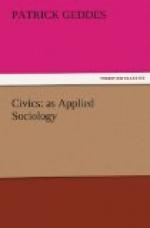Professor Geddes, in replying to the discussion, said he entirely agreed with the point made by Mr. Swinny, and he should just like to correct what he had said in his lecture by reference to what he meant by a civic museum. In Edinburgh, he had in his museum a large room, with a geographical model [Page: 118] of the old town with its hill-fort, and so on; and he hung round this maps and diagrams of historical and geographical details. On the opposite side of the room, he had a symbol of the market-cross, which stood for the centre of its municipal life, of its ideals and independence of environment. Around it was grouped what represented the other side of the city; and here he might answer another point, and say that they could never settle the great philosophical controversy of determinism and free-will. They would always incline when young to the novel of circumstance, and later, to the novel of character, but they should always feel that life was a game of individual skill with interfering circumstances. These diagrams of his were only the page split. On the one side, he meant to push to the extreme the idea that the place makes us, and on the other side, that we make the place. By what process do men struggle towards the selection of their ideals? They find themselves within the grasp of their environment, their whole heritage of culture, of good and ill, the whole tradition of the past; but they must select certain elements of these—the elements that seem to them good, and so they might escape from the manner of the city. Pointing to a drawing of the old Scotch bawbee, Professor Geddes said it was not a very dignified symbol of the coinage of the world, but let them mark how it had on the one side the hammerman at his work, with his motto “Beat deus artem,” and, on the other side, a larger legend, with the eagle of the empire and the lamb of Saint John.
To return to his civic museum: the room below the one he had described was the larger museum for Scotland, and in the room below that, again, the museum for England, Ireland and America, the whole English-speaking world—not the Empire only. And the whole stood on a museum and library representing that larger evolution of the occidental civilisation which showed them they were merely children of the past. Professor Geddes pleaded for museums in which every city displayed its own past and present, but related itself to the whole of Europe and the whole occident.
One or two practical questions of great importance had [Page: 119] been raised; but, with all respect, he submitted that they could consider what was practical and practicable without requiring to go into the question of taxing land. That was a matter of political opinion. It was as if they were discussing the geology of coal, which they could do, without reference to coal royalties. Mr. Weymouth was with them on the subject of preserving old buildings; and he thought there was a great deal to be learned, if Mr.




